Abstract
We evaluated effluent blood from extremities of human patients undergoing reconstructive surgical treatment, which is routinely accompanied by upper-extremity exsanguination and application of a tourniquet, resulting in total interruption of arterial blood flow to one upper extremity. After tourniquet release (reperfusion), there were immediate increases in the plasma levels of xanthine oxidase activity, uric acid, and histamine in the ipsilateral limb and much smaller increases, if any, in levels of the same materials in plasma obtained from the contralateral extremity. There was no detectable xanthine dehydrogenase activity in plasma from either limb. Plasma also contained evidence of products consistent with the formation of oxygen-derived free radicals, namely, the appearance predominantly in the reperfused limb of hemoglobin and fluorescent compounds. These data indicate for the first time in humans that ischemia-reperfusion events are associated with the appearance of xanthine oxidase activity and its products in the plasma effluent.
Full text
PDF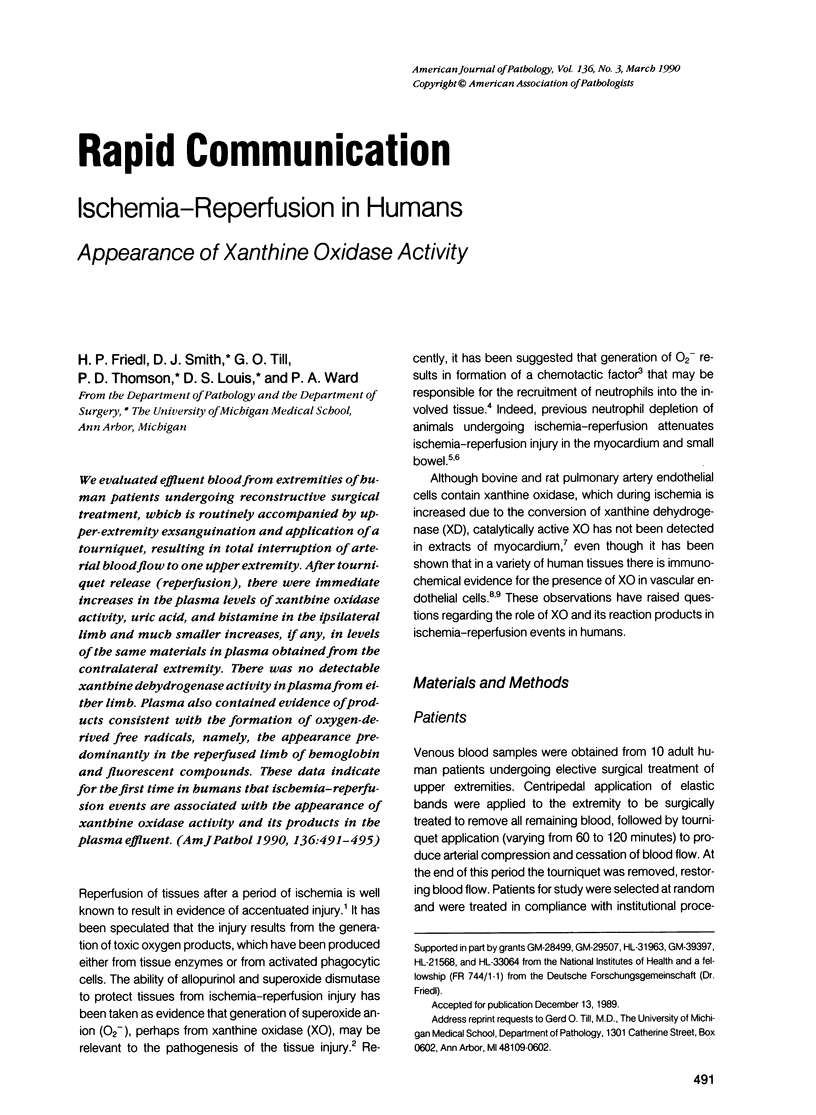
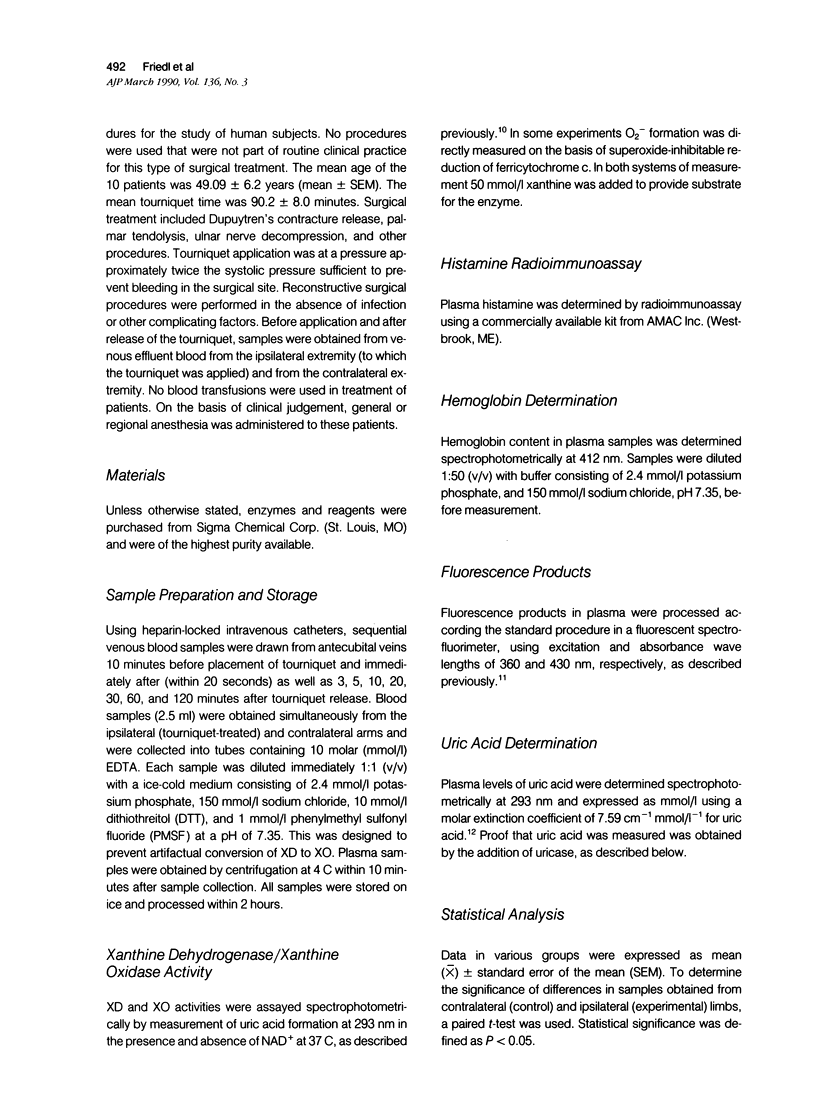
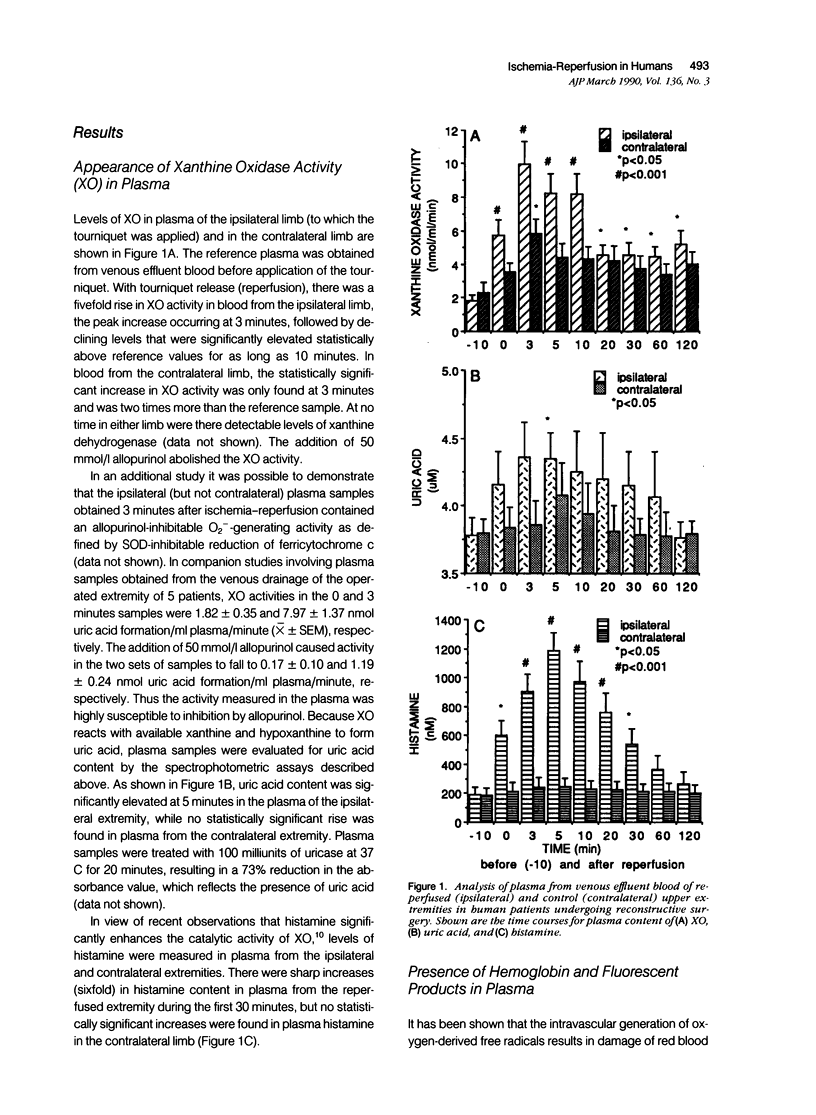
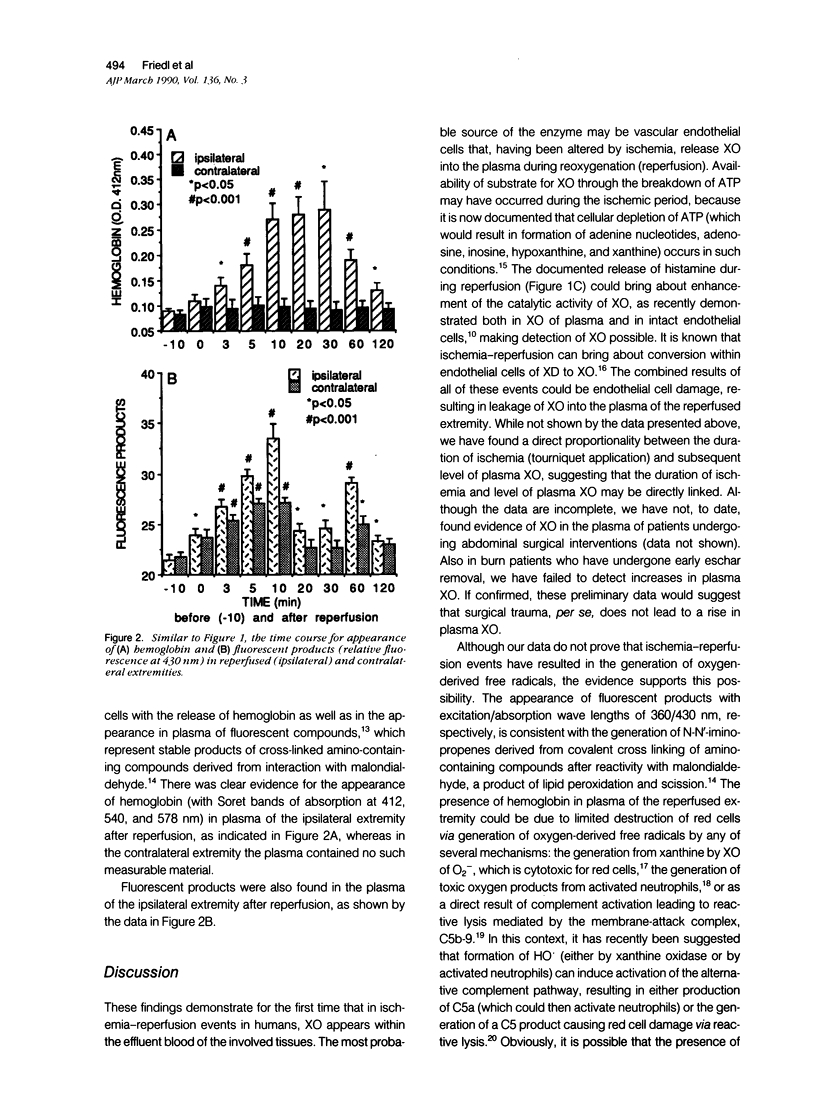
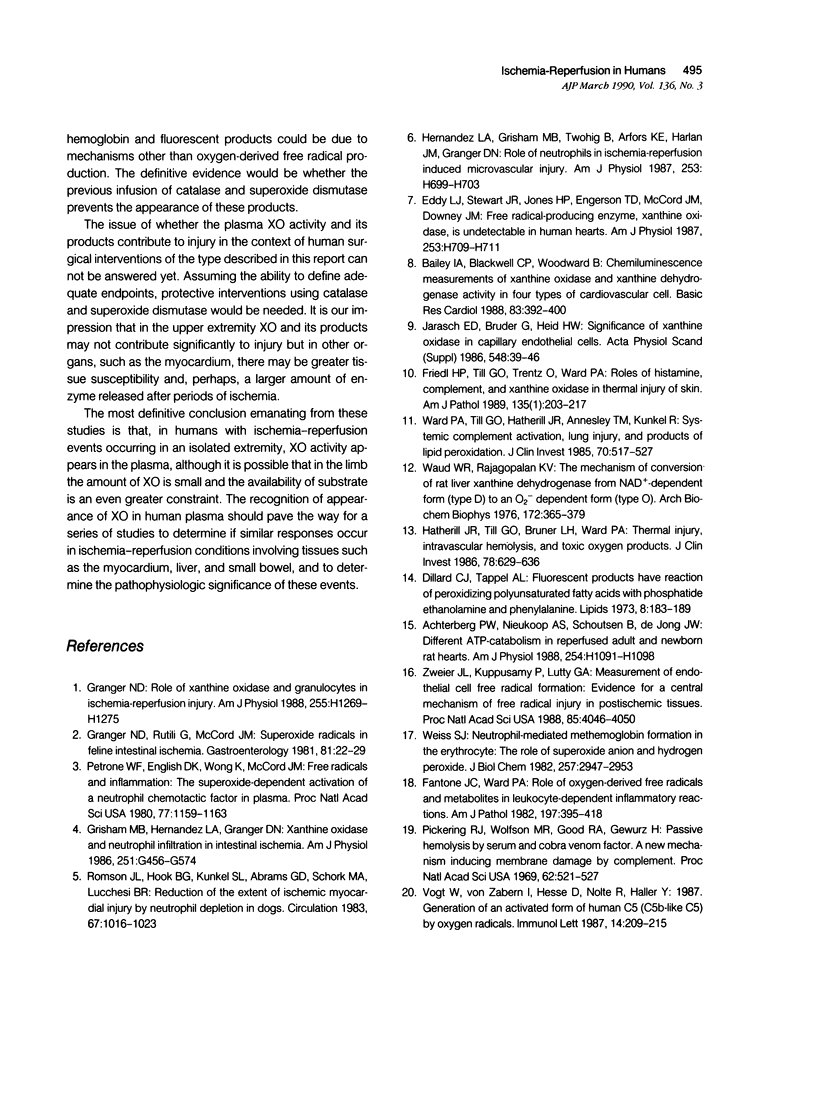
Selected References
These references are in PubMed. This may not be the complete list of references from this article.
- Achterberg P. W., Nieukoop A. S., Schoutsen B., de Jong J. W. Different ATP-catabolism in reperfused adult and newborn rat hearts. Am J Physiol. 1988 Jun;254(6 Pt 2):H1091–H1098. doi: 10.1152/ajpheart.1988.254.6.H1091. [DOI] [PubMed] [Google Scholar]
- Bailey I. A., Blackwell C. P., Woodward B. Chemiluminescence measurements of xanthine oxidase and xanthine dehydrogenase activity in four types of cardiovascular cell. Basic Res Cardiol. 1988 Jul-Aug;83(4):392–400. doi: 10.1007/BF02005825. [DOI] [PubMed] [Google Scholar]
- Dillard C. J., Tappel A. L. Fluorescent products from reaction of peroxidizing polyunsaturated fatty acids with phosphatidyl ethanolamine and phenylalanine. Lipids. 1973 Apr;8(4):183–189. doi: 10.1007/BF02544632. [DOI] [PubMed] [Google Scholar]
- Eddy L. J., Stewart J. R., Jones H. P., Engerson T. D., McCord J. M., Downey J. M. Free radical-producing enzyme, xanthine oxidase, is undetectable in human hearts. Am J Physiol. 1987 Sep;253(3 Pt 2):H709–H711. doi: 10.1152/ajpheart.1987.253.3.H709. [DOI] [PubMed] [Google Scholar]
- Fantone J. C., Ward P. A. Role of oxygen-derived free radicals and metabolites in leukocyte-dependent inflammatory reactions. Am J Pathol. 1982 Jun;107(3):395–418. [PMC free article] [PubMed] [Google Scholar]
- Friedl H. P., Till G. O., Trentz O., Ward P. A. Roles of histamine, complement and xanthine oxidase in thermal injury of skin. Am J Pathol. 1989 Jul;135(1):203–217. [PMC free article] [PubMed] [Google Scholar]
- Granger D. N. Role of xanthine oxidase and granulocytes in ischemia-reperfusion injury. Am J Physiol. 1988 Dec;255(6 Pt 2):H1269–H1275. doi: 10.1152/ajpheart.1988.255.6.H1269. [DOI] [PubMed] [Google Scholar]
- Granger D. N., Rutili G., McCord J. M. Superoxide radicals in feline intestinal ischemia. Gastroenterology. 1981 Jul;81(1):22–29. [PubMed] [Google Scholar]
- Grisham M. B., Hernandez L. A., Granger D. N. Xanthine oxidase and neutrophil infiltration in intestinal ischemia. Am J Physiol. 1986 Oct;251(4 Pt 1):G567–G574. doi: 10.1152/ajpgi.1986.251.4.G567. [DOI] [PubMed] [Google Scholar]
- Hatherill J. R., Till G. O., Bruner L. H., Ward P. A. Thermal injury, intravascular hemolysis, and toxic oxygen products. J Clin Invest. 1986 Sep;78(3):629–636. doi: 10.1172/JCI112620. [DOI] [PMC free article] [PubMed] [Google Scholar]
- Hernandez L. A., Grisham M. B., Twohig B., Arfors K. E., Harlan J. M., Granger D. N. Role of neutrophils in ischemia-reperfusion-induced microvascular injury. Am J Physiol. 1987 Sep;253(3 Pt 2):H699–H703. doi: 10.1152/ajpheart.1987.253.3.H699. [DOI] [PubMed] [Google Scholar]
- Jarasch E. D., Bruder G., Heid H. W. Significance of xanthine oxidase in capillary endothelial cells. Acta Physiol Scand Suppl. 1986;548:39–46. [PubMed] [Google Scholar]
- Petrone W. F., English D. K., Wong K., McCord J. M. Free radicals and inflammation: superoxide-dependent activation of a neutrophil chemotactic factor in plasma. Proc Natl Acad Sci U S A. 1980 Feb;77(2):1159–1163. doi: 10.1073/pnas.77.2.1159. [DOI] [PMC free article] [PubMed] [Google Scholar]
- Pickering R. J., Wolfson M. R., Good R. A., Gewurz H. Passive hemolysis by serum and cobra venom factor: a new mechanism inducing membrane damage by complement. Proc Natl Acad Sci U S A. 1969 Feb;62(2):521–527. doi: 10.1073/pnas.62.2.521. [DOI] [PMC free article] [PubMed] [Google Scholar]
- Romson J. L., Hook B. G., Kunkel S. L., Abrams G. D., Schork M. A., Lucchesi B. R. Reduction of the extent of ischemic myocardial injury by neutrophil depletion in the dog. Circulation. 1983 May;67(5):1016–1023. doi: 10.1161/01.cir.67.5.1016. [DOI] [PubMed] [Google Scholar]
- Ward P. A., Till G. O., Hatherill J. R., Annesley T. M., Kunkel R. G. Systemic complement activation, lung injury, and products of lipid peroxidation. J Clin Invest. 1985 Aug;76(2):517–527. doi: 10.1172/JCI112001. [DOI] [PMC free article] [PubMed] [Google Scholar]
- Waud W. R., Rajagopalan K. V. The mechanism of conversion of rat liver xanthine dehydrogenase from an NAD+-dependent form (type D) to an O2-dependent form (type O). Arch Biochem Biophys. 1976 Feb;172(2):365–379. doi: 10.1016/0003-9861(76)90088-6. [DOI] [PubMed] [Google Scholar]
- Weiss S. J. Neutrophil-mediated methemoglobin formation in the erythrocyte. The role of superoxide and hydrogen peroxide. J Biol Chem. 1982 Mar 25;257(6):2947–2953. [PubMed] [Google Scholar]
- Zweier J. L., Kuppusamy P., Lutty G. A. Measurement of endothelial cell free radical generation: evidence for a central mechanism of free radical injury in postischemic tissues. Proc Natl Acad Sci U S A. 1988 Jun;85(11):4046–4050. doi: 10.1073/pnas.85.11.4046. [DOI] [PMC free article] [PubMed] [Google Scholar]
- von Zabern W. V., Hesse D., Nolte R., Haller Y. Generation of an activated form of human C5 (C5b-like C5) by oxygen radicals. Immunol Lett. 1987 Feb;14(3):209–215. doi: 10.1016/0165-2478(87)90103-9. [DOI] [PubMed] [Google Scholar]


